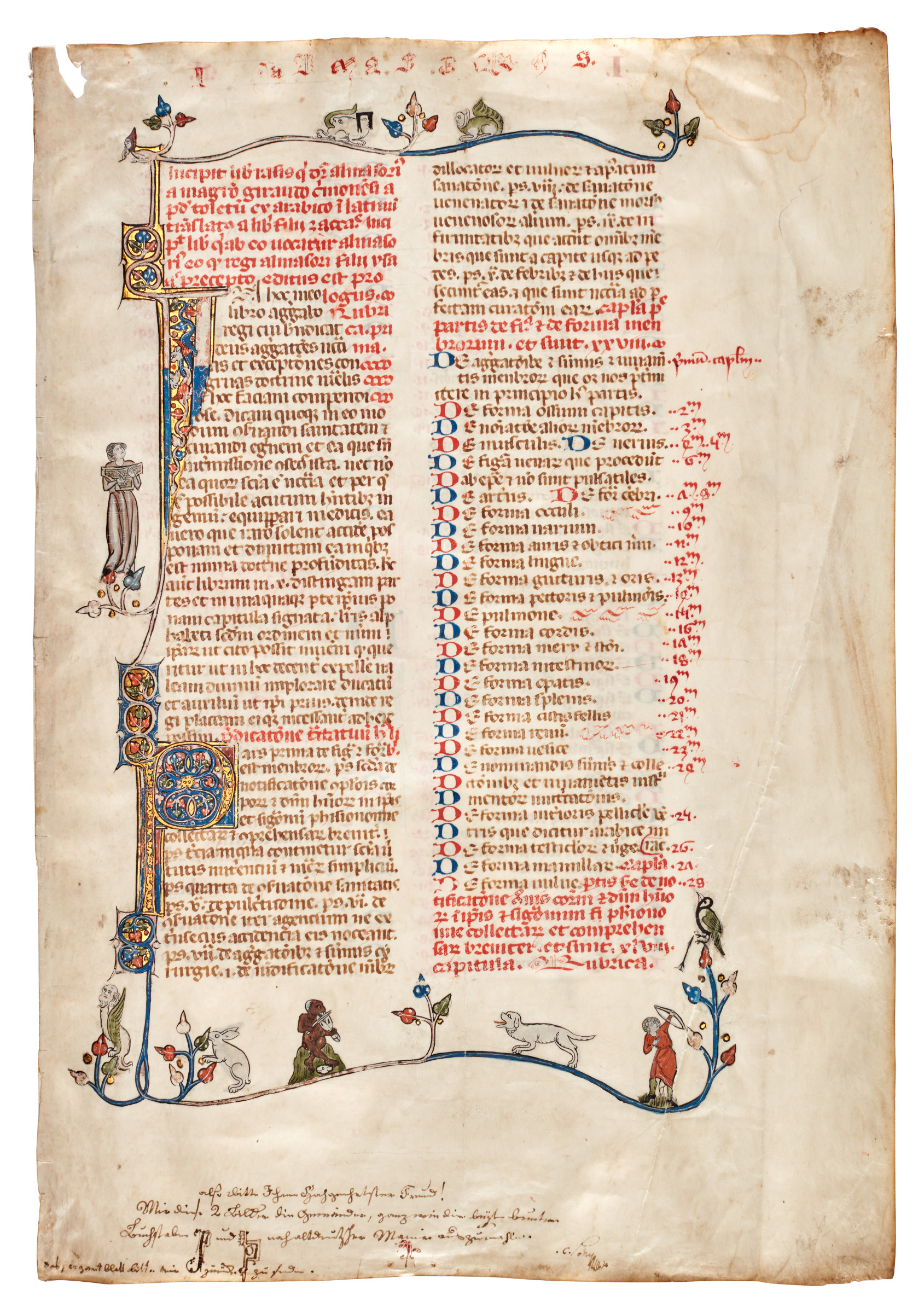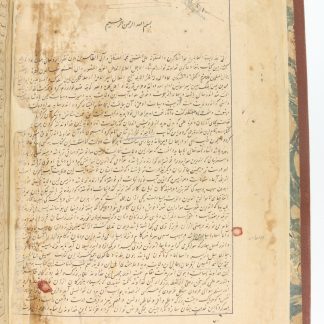Al-Razi's "Kitab al-tibb al-Mansuri": the first leaf of a Latin manuscript with highly original illumination
Nonus Almansoris, fol. 1. [Illuminated manuscript leaf].
Folio. Single leaf. Illuminated manuscript on vellum, decorated with numerous initials in red and blue, some with penwork flourishing, two incorporating dragons etc., with imaginatively historiated extensions.
€ 65.000,00
An imaginatively illuminated 14th century manuscript leaf Al-Rhazi's "Nonus Almansoris" (the famous Book IX of the "Book of Medicine dedicated to Mansur", often circulated as a separate work) in the influential Latin translation of Gerard of Cremona. On the extensions reaching around three sides of the text are perched animals, humans, and hybrid creatures, including a woman playing a dulcimer, a man shooting an arrow at a bird, and a dog barking at a violin-playing monkey.
Al-Rhazi, a native of Tehran, was a student of philosophy, logic, metaphysics, poetry, and music. He is said to have begun his medical studies at the age of 30 and soon became one of the most famous physicians of his day, as well as director of the hospital of Baghdad. Numerous books on medicine, chemistry, philosophy, and alchemy are attributed to his pen. Of the ten books of the encyclopedic "Liber Almansoris", Book IX concerns pathology, and it became a standard work on therapeutic medicine; it was translated, with commentaries, several times, and remained popular long after the medieval period, studied by such Renaissance physicians as Vesalius.
The present leaf, the first of the manuscript from which it was removed, was doubtless the most lavishly illuminated. The somewhat rounded, almost Italianate script and the rather pale brown ink suggest that it may have been written in southern France, perhaps at Montpellier, which in the 14th century was the leading centre in Europe for the study of medicine. The high quality of the illumination, however, suggests that it may have been decorated in Paris.
A lavishly illuminated leaf that embodies ninth-century Arabic learning translated into Latin in the twelfth-century Renaissance, and produced for a wealthy bibliophile in 14th century France.
The manuscript was demonstrably still in use in the 15th century, when its owner numbered the lists of chapters, using medieval Western Arabic numerals. In the 1780s, the leaf was in the collection of an unidentified German owner: the lower margin preserves his handwritten inscription to a friend, requesting retouching to the colours and initials. Subsequently offered by Hagop and Garbis Kalebdjian (Kalebdjian Frères) of Paris as their no. 537 and sold in 1924 to the American banker and art collector Robert Lehman (1891-1969) (his no. A.3, subsequently renumbered MS 6). By descent to his son Robin Lehman (b. 1936) and on deposit to the Metropolitan Museum, New York, until acquired in 2004 by the German manuscript dealer Jörn Günther. Subsequently in a UK private collection.
Folio (256 x 370 mm). Single leaf. Illuminated manuscript on vellum. Two columns, 48 lines, written in a somewhat round gothic bookhand in brown and red inks. Running title in the upper margin. Decorated with numerous single-line initials alternately red or blue, two- and three-line initials in red or blue with penwork flourishing and two large illuminated initials incorporating dragons etc., with imaginatively historiated extensions, carefully retouched in the late 18th century. Stored in custom-made cardboard portfolio.
One small hole in the inner upper corner and a light stain in the outer upper corner, neither affecting the text or decoration. Slight darkening of the outer edges, slight wear to the running title, minor flaking of pigments and gold, but overall in very fine condition.
Seymour de Ricci & W. J. Wilson, Census of Medieval and Renaissance Manuscripts in the United States and Canada, II (New York, The Bibliographical Society of America, 1937; repr. 1961), p. 1704. GAL S I, p. 419.







